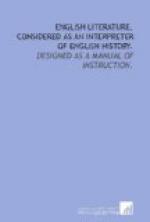CHAPTER XXVI.
STEELE AND SWIFT.
Sir Richard Steele. Periodicals.
The Crisis. His Last Days. Jonathan
Swift—Poems. The
Tale of a Tub. Battle of the Books. Pamphlets.
M. B.
Drapier. Gulliver’s Travels.
Stella and Vanessa. His Character and
Death.
Contemporary with Addison, and forming with him a literary fraternity, Steele and Swift were besides men of distinct prominence, and clearly represent the age in which they lived.
SIR RICHARD STEELE.—If Addison were chosen as the principal literary figure of the period, a sketch of his life would be incomplete without a large mention of his lifelong friend and collaborator, Steele. If to Bacon belongs the honor of being the first writer and the namer of the English essay, Steele may claim that of being the first periodical essayist.
He was born in Dublin, in 1671, of English parents; his father being at the time secretary to the Lord Lieutenant of Ireland. He received his early education at the Charter-House school, in London, an institution which has numbered among its pupils many who have gained distinguished names in literature. Here he met and formed a permanent friendship with Addison. He was afterwards entered as a student at Merton College, Oxford; but he led there a wild and reckless life, and leaving without a degree, he enlisted as a private in the Horse Guards. Through the influence of his friends, he was made a cornet, and afterwards a captain, in the Fusileers; but this only gave him opportunity for continued dissipation. His principles were better than his conduct; and, haunted by conscience, he made an effort to reform himself by writing a devotional work called The Christian Hero; but there was such a contrast between his precepts and his life, that he was laughed at by the town. Between 1701 and 1704 he produced his three comedies. The Funeral, or Grief a la Mode; The Tender Husband, and The Lying Lover. The first two were successful upon the stage, but the last was a complete failure. Disgusted for the time with the drama, he was led to find his true place as the writer of those light, brilliant, periodical essays which form a prominent literary feature of the reign of Queen Anne. These Essays were comments, suggestions, strictures, and satires upon the age. They were of immediate and local interest then, and have now a value which the writers did not foresee: they are unconscious history.
PERIODICALS.—The first of these periodicals was The Tatler, a penny sheet, issued tri-weekly, on post-days. The first number appeared on the 12th of April, 1709, and asserted the very laudable purpose “to expose the deceits, sins, and vanities of the former age, and to make virtue, simplicity, and plain-dealing the law of social life.” “For this purpose,” in the words of Dr. Johnson,[34] “nothing is so proper as the frequent publication of short papers, which we read not as study, but amusement. If the subject be slight, the treatise is short. The busy may find time, and the idle may find patience.” One nom de plume of Steele was Isaac Bickerstaff, which he borrowed from Swift, who had issued party-pamphlets under that name.




